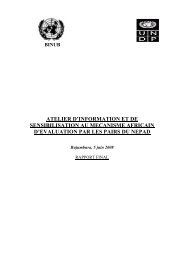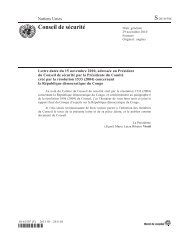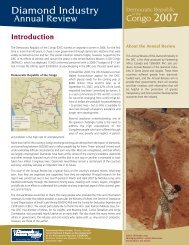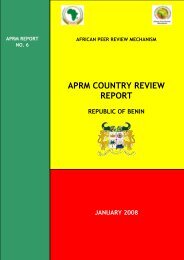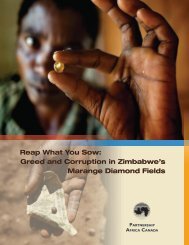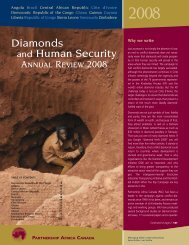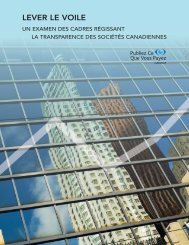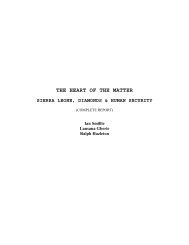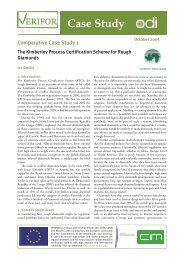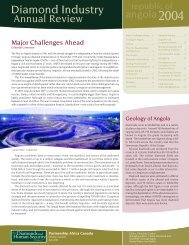Angola 2007 - Diamond Development Initiative
Angola 2007 - Diamond Development Initiative
Angola 2007 - Diamond Development Initiative
- No tags were found...
You also want an ePaper? Increase the reach of your titles
YUMPU automatically turns print PDFs into web optimized ePapers that Google loves.
Endiama is also charged with minimizing lasting damage to the nation’ssoil and rivers by ensuring that diamond projects comply with <strong>Angola</strong>’senvironmental regulations. There is simply no way to reconcile these tworoles.The contracts negotiated with joint venture companies do contain aclause requiring an environmental impact study. Theoretically, accordingto Endiama’s Director of Geology Miguel Paulino Augusto de Almeida, ifEndiama the regulator feels Endiama the shareholder is not in compliancewith environmental standards, Endiama can dispatch personnel to investigateitself and report back on its performance. If Endiama finds thatEndiama is violating the regulations, it can issue a report telling itself toshape up. There are no provisions for fines in the regulations, however,so Endiama can’t actually fine itself, even if it continues to ignore its warnings.This would be faintly comical if the problem were not also real.Interviewed by the Annual Review in his office in Dundo, Lunda Norte,the provincial governor Gomes Maiato said that erosion was an issue atseveral alluvial mines, and that more rigorous enforcement of the environmentalregulations was one of the changes he wanted. A member ofthe governor’s staff, who had personally visited every mine in theprovince, there were serious erosion problems at all the alluvial miningprojects. 27In Luanda, however, officials at Endiama had a much more sanguine attitude.Asked whether Endiama had any plans to train or bring on any specialistsin environmental engineering, Geology Director Almeida repliedthat because any course in mining engineering these days contains anenvironmental component, every mining engineer is by definition anenvironmental engineer. Endiama therefore had all the expertise it needed.As for the damage wrought by diamond mining, Director Almeidareferred to a pair of studies: the first, possibly by a Portuguese university,showed that because of fecundity of the <strong>Angola</strong>n countryside, pits fromgarimpo tended to recover spontaneously. The other, a catalogue of mining-engenderedenvironmental damage throughout <strong>Angola</strong>, apparentlyproved that the vast majority of the damage had been wrought duringthe colonial era, and was therefore no fault of Endiama’s. The Directorhad not actually read these studies, nor seen them, nor were there copiesavailable in Endiama’s library. But he had heard of them, and was surethat they supported his case.Endiama’s attitude is proof, if any were needed, that empowering oneagency as both regulator and industry participant is simply an untenablesituation. Far from balancing short term profit with long term sustainability,the eagerness with which Endiama executives grasp at the flimsiest offig leaves suggests that the government corporation has come downfirmly on the side of profit. All the more reason, then, for the <strong>Angola</strong>ngovernment to strip Endiama of its role in environmental oversight.Sources in the Ministry of Geology and Mines say that a seminar on environmentalissues in the diamond sector was held in Saurimo in July, <strong>2007</strong>,and that as a result diamond companies have begun working on puttingtogether environmental programs. While this is laudable, if belated,progress, experience elsewhere in the world suggests that mining companieswill never take environmental mitigation seriously without a crediblethreat of fines and/or stop-work orders by an outside regulatoryagency.RecommendationsTo the Government of <strong>Angola</strong>1. As a first priority, the <strong>Angola</strong>n government urgently needs to developan effective, transparent, believable system for tracking informal (artisanal)alluvial diamonds from production to export. The system as itstands is non-functional, and violates <strong>Angola</strong>’s commitments under theKimberley Process.a) As a first step, <strong>Angola</strong>n authorities should develop a paper-basedtracking system, with all buyers at all levels recording the purchaseand sale of all artisanal diamonds on standardized forms, thus providinga paper trail as diamonds move from garimpeiro, to first-levelbuyer, to mother house (casa mae) to Sodiam in Luanda. Formsshould include the date, location of purchase, weight, quality andthe identity of the seller and buyer. At regular intervals, the datafrom these forms should be collated and sent, together with copiesof the forms themselves, to the Kimberley Process authority inLuanda. Such a paper system will be a major advance in trackingand controlling <strong>Angola</strong>n garimpeiro production. For examples ofsuch a system, <strong>Angola</strong> may wish to study the KP systems currentlyin operation in Guyana, Liberia and Brazil.b) Using information from the paper-based system, <strong>Angola</strong> shoulddevelop a computerized database to track artisanal production fromsource to export. The data collated from the transaction formswould form the basic input to this system. With such a system inplace, the <strong>Angola</strong>n KP authority, as well as the CSD or other investigativeauthority, could perform checks to see that all of the diamondsthat enter the system duly exit the system in legal ways. Thesystem would also provide <strong>Angola</strong> with the ability to analyse whichparts of the country have the most active garimpeiro sector. Again,Guyana, Liberia and Brazil all have working prototypes in placewhich <strong>Angola</strong> could profitably study before implementing its own.c) It is a clear conflict of interest for Sodiam – the owner and exporterof <strong>Angola</strong>’s diamonds – to act as the effective KP certifying authorityfor these same diamonds. For the sake of credibility and transparency,the task of certifying <strong>Angola</strong>n diamonds should be carriedout - in practice as well as on paper, entirely by the Ministry ofGeology and Mines.20



